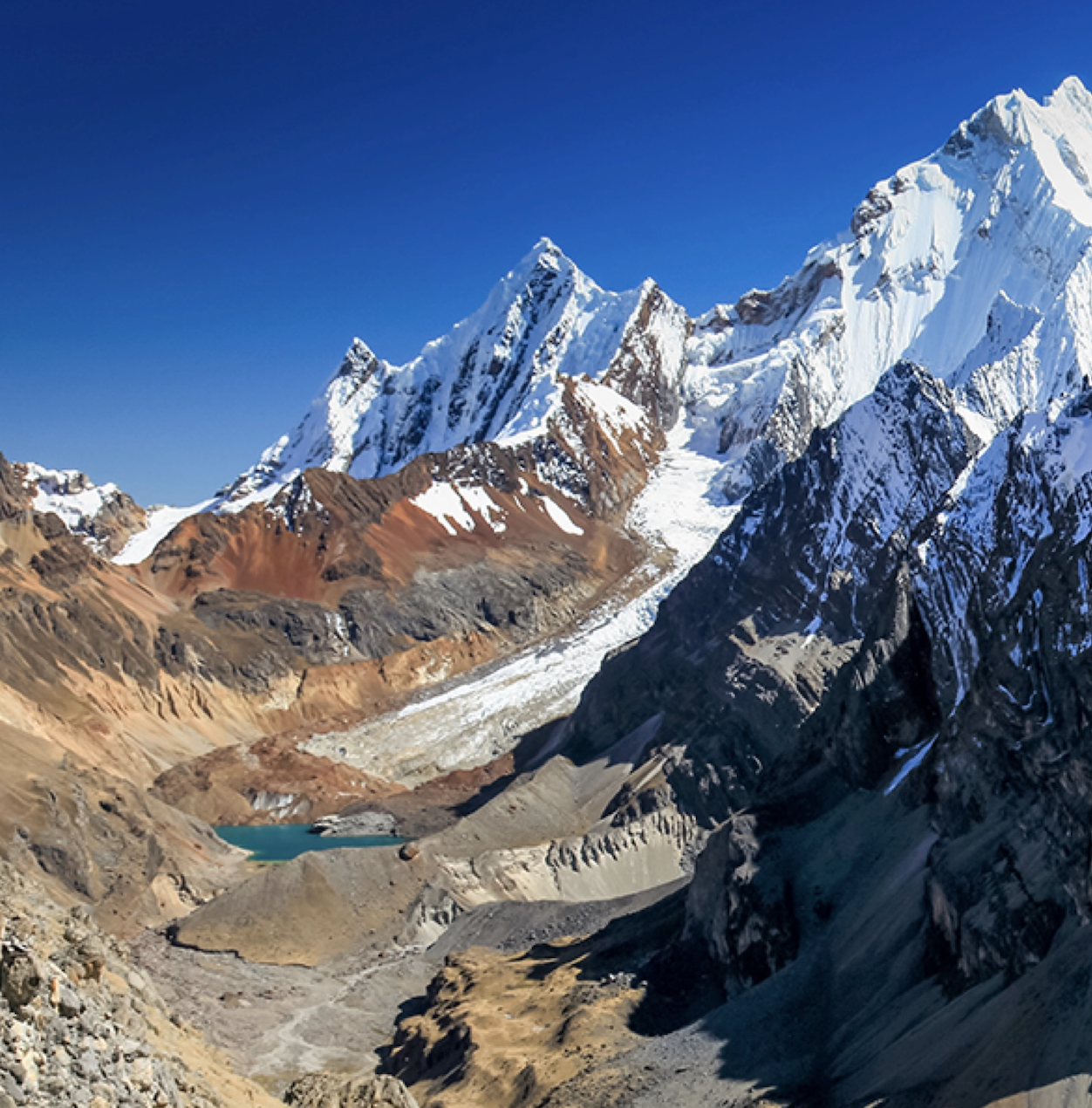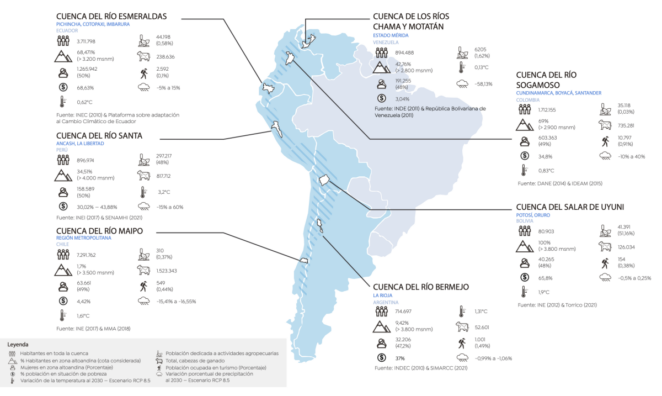The high Andean basins face climate change: Results from seven case studies on vulnerability

Vulnerability to climate change in the High Andes
The projections of climatic scenarios in the Andean territory estimate a significant increase in temperature, particularly in areas of higher altitude. Temperatures are estimated to reach an increase of up to 0.2°C per decade in areas above 3000 metres above sea level, altering the way of life of millions of people in rural areas. But the effects will be different in each region, as each socio-ecosystem in the Andes is a unique case. Finding a common strategy to deal with the effects of climate change requires a thorough assessment of differences and commonalities.
Contributing to this process, the Andean Mountain Initiative (AMI) has published a Policy Brief based on the study “Vulnerability and adaptation to climate change in high mountain areas of the Andean region: Argentina, Bolivia, Chile, Colombia, Ecuador, Peru and Venezuela”. This is a product foreseen in the 2022 – 2026 Action Plan of the AMI, and it was prepared by the consulting firm DEUMAN, with the technical and economic support of the Adaptation in at Altitude-Andes project (financed by SDC), IKI and Euroclima+, through the UN Environment Program (UNEP) and the Consortium for the Sustainable Development of the Andean Ecoregion (CONDESAN).
The study:
- Carries out a general analysis of vulnerability to the effects of climate change at the regional level, focusing on water resources in the high Andean areas. The impacts on agriculture, livestock, tourism and ecosystems are detailed.
- Identifies seven basins, one for each Andean country, selected for their characteristics and importance in coordination with the member countries of the AMI.
- Conducts an assessment of the state of the basin and projections of climate change impacts for the rural economic activities.
- Identifies knowledge gaps and key thematic areas, and suggests a series of recommendations to reduce climate vulnerability in the Andes.
This article is an abridged version of the original text, which can be downloaded from the right-hand column (in Spanish) or accessed under the related resources section (in English). Please access the original text for more detail, research purposes, full references, or to quote text.
Seven strategic basins
The study area is defined based on four premises, depending on each national context:
- The concept and classification of hydrographic basins
- The elevation of the area in relation to the ecosystems or eco-regions
- Whether a significant area of the basin has high mountains
- Whether the basin head is located in the mountain range
Four basins were selected in each country for a multi-criteria analysis based on availability of information, national relevance, institutionality and governance.
The pre-selected basins were then evaluated with five criteria:
- Climatic hazard (variation of mean annual temperature and annual precipitation)
- Vulnerable population (% women, % children, % older adults, % poverty and % ethnic-indigenous population)
- Economic-productive population in rural livelihoods (agriculture, tourism and livestock)
- Socio-environmental conflicts related to water resources and ecosystems
- Adaptation projects executed
The methodological framework identified seven hydrographic basins with high vulnerability to climate change in the Andean region: the Bermejo river in Argentina, the Salar de Uyuni in Bolivia, the Maipo River in Chile, the Sogamoso River in Colombia, the Esmeraldas River in Ecuador, the Santa River in Peru, and the Chama and Motatán Rivers in Venezuela. In each of these areas, adaptation projects carried out or in progress were identified, and a series of socio-environmental variables were evaluated to characterise each basin and inform future climate change scenario projections. Variables included:
- Population of the entire basin
- Percentage of inhabitants of the basin that live in the High Andes zone
- Percentage of women, population living in poverty, population employed in tourism and population dedicated to agricultural activities
- Total head of cattle
- Precipitation percentage change and temperature variations to 2030 under RCP 8.5 Scenario

Results: A complex scenario
In the social aspect, the study detected greater vulnerability of ethnic minorities and rural women, due to the high dependence of their economic activities on the ecosystem services of the high Andean areas. The reduction of these activities on a local scale will result in a decrease in their economic income, also affecting their food security. Of the cases studied, the Salar de Uyuni and Esmeraldas River basins stand out for their greater social vulnerability due to inequality in the regions.
Regarding agriculture, climate change is expected to affect the productivity of crops in the High Andes region in a differentiated way according to each case. For example, in the high Andean zone of the Sogamoso river basin, a severe increase in the percentage of annual rainfall (+40%) has been projected, increasing the risk of flooding and landslides. Conversely, in the basins of the Salar de Uyuni and the Santa, Esmeraldas and Chama-Motatán rivers, the projected decrease in rainfall may generate water stress in crops.
A similar, mixed scenario is expected in activities related to livestock: deaths of cattle and changes in pasture due to drought have been reported in some areas (Salar de Uyuni, Santa river, Bermejo river), while in others, such as the Sogamoso river, the increase in rainfall would favour changes in the composition/structure of grasslands.
Glacial retreat would directly impact the basins whose irrigation systems are supplied directly from rivers of glacial origin; but also tourism, another way of life investigated in the study. It is observed that nature tourism is already being affected by the loss of biodiversity and the impacts on ecosystems, generating a loss of scenic beauty and cultural identity. For example, the surface of the Salar de Uyuni salt flat has darkened due to droughts; and in the Maipo river basin, the reduction of flows has impacted touristic activities such as canoeing. The rapid reduction of glaciers is already diminishing the flow of visitors in mountains where hiking, climbing and skiing is practised, such as in the Maipo, Sogamoso and Santa river basins.
Recommendations for an adaptation strategy
To strengthen the adaptive capacity of communities and high Andean ecosystems, five lines of work related to ecosystem-based adaptation are proposed:
- Sustainable livestock farming: including sustainable grazing systems, implementation of mixed fodder banks, and improvement of breeding techniques of camelids.
- Sustainable agriculture and agro-ecology: including conservation of agrodiversity, recovery of local varieties with greater tolerance to extreme conditions, diversification of agro-ecosystems to increase functional diversity and resilience, and integrated pest management.
- Tourism transformation: focus on ecotourism and the use of cultural ecosystem services; including within an environmental education strategy and through community models, such as support to adapt rural homes to accommodate tourists.
- Water security: including implementation or recovery of systems for planting and harvesting water; incorporation of ancestral technologies, and systems for the efficient use of agricultural water.
- Ecosystem and biodiversity conservation: including regeneration and conservation of high Andean ecosystems, species repopulation programs, support for germplasm banks of threatened native populations, strengthening of National Protected Areas, and promotion of monitoring and co-operation models, with greater participation of local communities.
The study also identifies a series of measures necessary for the implementation of the recommendations, such as strengthening the capacities of local governments and the community, improving public investment in climate change adaptation measures, monitoring adaptation projects, strengthening of governance and institutions at the national, basin, and local levels, and strengthening of hydroclimatic and biodiversity monitoring.
With this Policy Brief, the AMI provides a fundamental tool for regional, national and local adaptation to climate change of the high Andean communities and ecosystems.
To explore the experiences and opportunities for different sectors, key gaps and knowledge requirements, and regional recommendations in more detail please refer to the full policy brief (in Spanish).
Related Resources
Suggested Citation:
Iniciativa Andina de Montañas. (IAM, 2023). Vulnerabilidad y adaptación al cambio climático en zonas de alta montaña de la región andina. Estudio regional organizado por el Consorcio para el Desarrollo Sostenible de la Ecorregión Andina (CONDESAN) y el Programa de las Naciones Unidas para el Medio Ambiente (PNUMA). Elaborado por DEUMAN.
Related resources
- Vulnerability and adaptation to climate change in high mountain areas of the Andean region (2023) - English
- Long-Term Social-Ecological Monitoring in the Andes: How are we doing?
- Building strongholds for people and nature in the high Andes: Saving and restoring wetlands
- State of the Cryosphere Report 2022
- Mountain observations: Monitoring, data, and information for science, policy, and society
- The Andes Monitoring Networks strengthen their skills in the course "Analysis of vegetation dynamics data in the Andes"
(0) Comments
There is no content